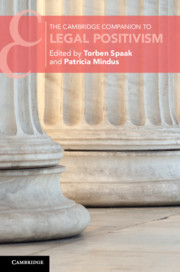Book contents
- The Cambridge Companion to Legal Positivism
- Cambridge Companions to Law
- The Cambridge Companion to Legal Positivism
- Copyright page
- Contents
- Figures
- Contributors
- Acknowledgements
- 1 Introduction
- Part I Fundamentals
- 2 Positivism, Realism and Sources of Law
- 3 Normative Legal Positivism
- 4 Legal Positivism as a Realist Theory of Law
- Part II History
- Part III Central Figures
- Part IV Main Tenets
- Part V Normativity and Values
- Part VI Critique
- Index
- References
3 - Normative Legal Positivism
from Part I - Fundamentals
Published online by Cambridge University Press: 21 January 2021
- The Cambridge Companion to Legal Positivism
- Cambridge Companions to Law
- The Cambridge Companion to Legal Positivism
- Copyright page
- Contents
- Figures
- Contributors
- Acknowledgements
- 1 Introduction
- Part I Fundamentals
- 2 Positivism, Realism and Sources of Law
- 3 Normative Legal Positivism
- 4 Legal Positivism as a Realist Theory of Law
- Part II History
- Part III Central Figures
- Part IV Main Tenets
- Part V Normativity and Values
- Part VI Critique
- Index
- References
Summary
Schauer discusses normative positivism, explaining that this type of positivism comes in two main versions, namely, in the shape of a prescription to legal actors and in the shape of a prescription to legal institutional designers. He argues that a full appreciation of the artefactual nature of law leads to the conclusion that a culture can modify its concept of law in order to make it as useful a concept as possible, and that if normative positivism is a plausible position, it follows not only that choosing a concept of law on moral grounds is a moral position but also that choosing to see the enterprise of legal theory in a normative way itself amounts to a normative position.
- Type
- Chapter
- Information
- The Cambridge Companion to Legal Positivism , pp. 61 - 78Publisher: Cambridge University PressPrint publication year: 2021
References
- 4
- Cited by

